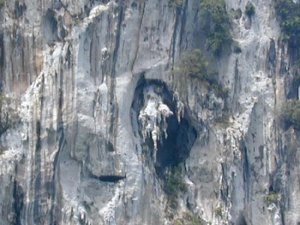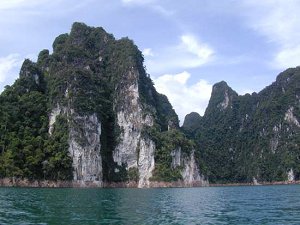|
|
matt salleh Reefs to Rainforests |
|
Introduction
Two hundred and sixty million years ago
marine organisms and corals thrived in a warm shallow sea that had yet to be named by human imagination. As sure as time, sand and mud gave way to the slow and steady erosional forces of wind and water. Eventually the sand drifted to rest on top of the ancient marine organisms and corals. The calcium carbonate in those critter's bodies compressed under the immense weight of the marine silt and gradually transformed into an intricately complex limestone formation.
Sixty million years ago
the Indian subcontinent began crashing into the Asian mainland. The collision was so powerful that it rotated the whole of Southeast Asia clockwise. It also lifted the newly formed limestone and set the stage for the beginnings of a set of mountains that would someday be known as the Himalayas. When talking about these things we like to say “crashing” and “collision”. That adds to the drama. But really it is a matter of scale and perspective. The “crashing” and “colliding” take place over millions of years, which is a slow process from the human perspective. It is, in fact, still taking place and we rarely notice. However, we do periodically feel the effects of plates colliding. We call the collisions earthquakes, which, on second thought is quite dramatic indeed. Nonetheless, it takes a time longer than most people can imagine or visualize for plates to move and collide and mountains to form. Although, if we realize that geologic time deals in millions, tens of millions and hundreds of millions of years as if they were seconds, minutes, and hours we might have a more accurate perspective.
Beginning about sixty million years ago
and continuing until today the uplifted limestone formation eventually began to erode. By rains and wind it was exposed as cliffs in a country presently named Thailand by a newly evolved species that would name themselves Homo sapiens sapiens or, in plain English, ‘wise men’. By many accounts human-like creatures have inhabited this planet for nearly 1 million years, a hiccup when viewed from the geologic perspective. These ‘wise men’ have altered the planet greatly in their short, ephemeral existence. Because of the actions of ‘wise men’ the ancient forests and corals, as well as their inhabitants, that took hundreds of millions of years to form and evolve are now disappearing at a pace that has never before been witnessed.
Seventeen days ago
Geetha and I traveled from our home in Kuala Lumpur to the south of Thailand to witness the magnificence and glory that nature had produced over the last couple of hundred million years. We may be one of the last generations to be able say such things. If I have anything to do with it, I will prove myself a liar.
We flew into Phuket Island a day early. We wanted to avoid exhaustion and circumvent the hassle of rushing to meet the other folks that had signed up for the ‘Reefs to Rainforest’ class offered by Thom Henley. The class promised a seven-day tour of seven different ecosystems located on the Isthmus of Kra in southern Thailand. We were excited. We weren’t sure what to expect. We weren’t sure how many others would join us. We were only sure that we would learn about, experience and witness things few others were aware of, much less had seen.
The Chapters of Reefs to Rainforests...
| |||||||||||||||||||||||||||||||||||||||||


